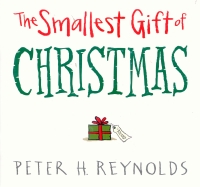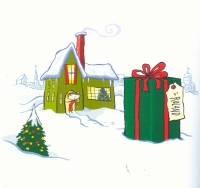| ________________
CM . . .
. Volume XX Number 19. . . .January 17, 2014
excerpt:
In The Smallest Gift of Christmas, by Peter H. Reynolds, Roland is very excited for Christmas to arrive. When he races downstairs on Christmas Day though, he is disappointed to see that his Christmas present is very small. Before even opening his present, Roland has a fit and wishes for a bigger present. When he realizes that his wish has come true, he decides that even the new present is not big enough, and so he continues to wish for bigger and bigger presents as none seem to live up to his large expectations. Roland storms off when even a present nearly the size of his house is not big enough. Eventually, Roland sets out to search the universe for the biggest present ever, but he soon realizes that everything and everyone he knows and loves is getting smaller and smaller as he explores space and that maybe, just maybe, something small could be something he wanted very badly. Roland soon learns that there is value in things that appear small, and he returns home to reunite with his family and spend Christmas with them.
The illustrations are the biggest strength of this story. The illustrations are simple and have a slight Dr. Seuss quality to them. They are basic black and white filled in with just a few bright colors, mostly red and green. The focus on red and green also makes the story feel especially festive. There is some amusing humour thrown into the illustrations, such as Roland's stocking being three times the size of everyone else's and dragging on the floor. Roland's face is drawn to be particularly expressive, and his expressions really sell the emotion of the story. Overall, this story is fun to read and look at and has a positive message for children, one that is an especially useful reminder at Christmas when people can lose focus and become overly self-centered. It would be a good purchase for school and public libraries with the caveat that parents may want to consider their audience before reading. Recommended. Carla Epp is a librarian with Winnipeg Public Library in Winnipeg, MB.
To comment
on this title or this review, send mail to cm@umanitoba.ca.
Copyright © the Manitoba Library Association. Reproduction for personal
use is permitted only if this copyright notice is maintained. Any
other reproduction is prohibited without permission.
NEXT REVIEW |
TABLE OF CONTENTS FOR THIS ISSUE
- January 17, 2014.
AUTHORS |
TITLES |
MEDIA REVIEWS |
PROFILES |
BACK ISSUES |
SEARCH |
CMARCHIVE |
HOME |

 The Smallest Gift of Christmas is a fun story that accurately captures the emotions experienced by children who may be disappointed by what they find under the Christmas tree or as a birthday present. It also plays out the (admittedly) extreme consequences of acting on one's feelings. Many children might feel as if they would like to react like Roland but know that it is not appropriate, and so they may enjoy seeing how Roland comes full circle and begins to understand that throwing a fit and storming off is not a proper reaction, particularly before he even opens his gift to see what it is. One concern with this story though may be that young, impressionable children may emulate Roland's bad behavior. Consequently, parents may want to exercise caution.
The Smallest Gift of Christmas is a fun story that accurately captures the emotions experienced by children who may be disappointed by what they find under the Christmas tree or as a birthday present. It also plays out the (admittedly) extreme consequences of acting on one's feelings. Many children might feel as if they would like to react like Roland but know that it is not appropriate, and so they may enjoy seeing how Roland comes full circle and begins to understand that throwing a fit and storming off is not a proper reaction, particularly before he even opens his gift to see what it is. One concern with this story though may be that young, impressionable children may emulate Roland's bad behavior. Consequently, parents may want to exercise caution.